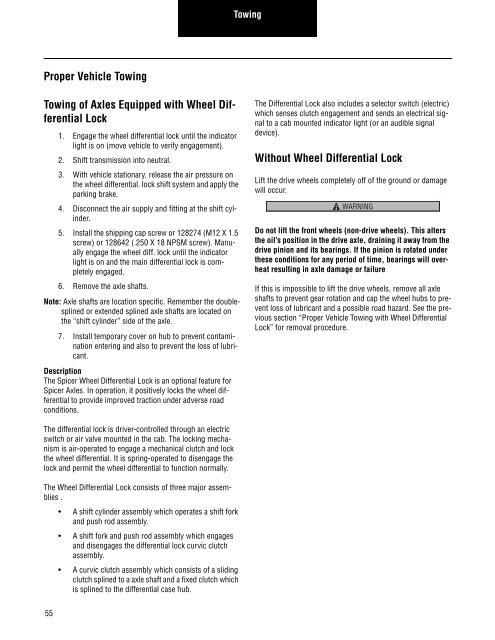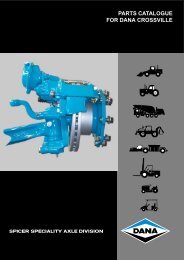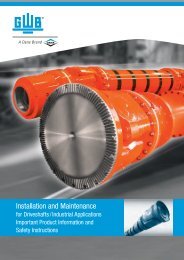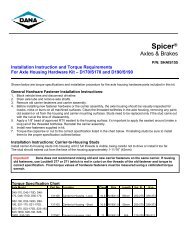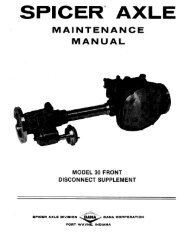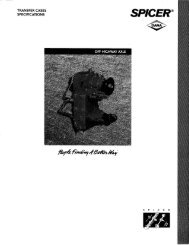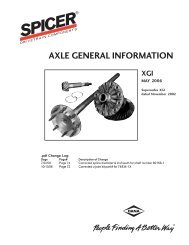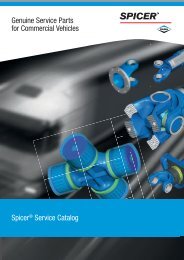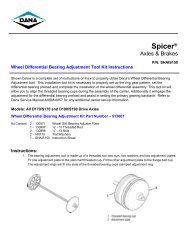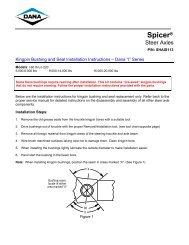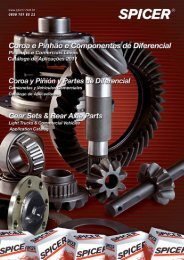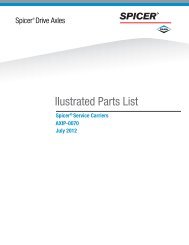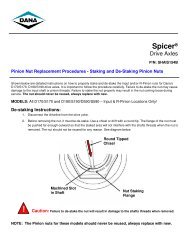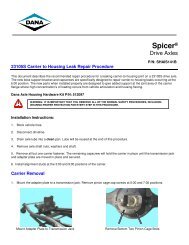Single Reduction & Single Reduction with Differential Lock - Spicer
Single Reduction & Single Reduction with Differential Lock - Spicer
Single Reduction & Single Reduction with Differential Lock - Spicer
You also want an ePaper? Increase the reach of your titles
YUMPU automatically turns print PDFs into web optimized ePapers that Google loves.
Proper Vehicle Towing<br />
Towing of Axles Equipped <strong>with</strong> Wheel <strong>Differential</strong><br />
<strong>Lock</strong><br />
55<br />
1. Engage the wheel differential lock until the indicator<br />
light is on (move vehicle to verify engagement).<br />
2. Shift transmission into neutral.<br />
3. With vehicle stationary, release the air pressure on<br />
the wheel differential. lock shift system and apply the<br />
parking brake.<br />
4. Disconnect the air supply and fitting at the shift cylinder.<br />
5. Install the shipping cap screw or 128274 (M12 X 1.5<br />
screw) or 128642 (.250 X 18 NPSM screw). Manually<br />
engage the wheel diff. lock until the indicator<br />
light is on and the main differential lock is completely<br />
engaged.<br />
6. Remove the axle shafts.<br />
Note: Axle shafts are location specific. Remember the doublesplined<br />
or extended splined axle shafts are located on<br />
the “shift cylinder” side of the axle.<br />
7. Install temporary cover on hub to prevent contamination<br />
entering and also to prevent the loss of lubricant.<br />
Description<br />
The <strong>Spicer</strong> Wheel <strong>Differential</strong> <strong>Lock</strong> is an optional feature for<br />
<strong>Spicer</strong> Axles. In operation, it positively locks the wheel differential<br />
to provide improved traction under adverse road<br />
conditions.<br />
The differential lock is driver-controlled through an electric<br />
switch or air valve mounted in the cab. The locking mechanism<br />
is air-operated to engage a mechanical clutch and lock<br />
the wheel differential. It is spring-operated to disengage the<br />
lock and permit the wheel differential to function normally.<br />
The Wheel <strong>Differential</strong> <strong>Lock</strong> consists of three major assemblies<br />
.<br />
• A shift cylinder assembly which operates a shift fork<br />
and push rod assembly.<br />
• A shift fork and push rod assembly which engages<br />
and disengages the differential lock curvic clutch<br />
assembly.<br />
• A curvic clutch assembly which consists of a sliding<br />
clutch splined to a axle shaft and a fixed clutch which<br />
is splined to the differential case hub.<br />
Towing<br />
The <strong>Differential</strong> <strong>Lock</strong> also includes a selector switch (electric)<br />
which senses clutch engagement and sends an electrical signal<br />
to a cab mounted indicator light (or an audible signal<br />
device).<br />
Without Wheel <strong>Differential</strong> <strong>Lock</strong><br />
Lift the drive wheels completely off of the ground or damage<br />
will occur.<br />
WARNING<br />
Do not lift the front wheels (non-drive wheels). This alters<br />
the oil’s position in the drive axle, draining it away from the<br />
drive pinion and its bearings. If the pinion is rotated under<br />
these conditions for any period of time, bearings will overheat<br />
resulting in axle damage or failure<br />
If this is impossible to lift the drive wheels, remove all axle<br />
shafts to prevent gear rotation and cap the wheel hubs to prevent<br />
loss of lubricant and a possible road hazard. See the previous<br />
section “Proper Vehicle Towing <strong>with</strong> Wheel <strong>Differential</strong><br />
<strong>Lock</strong>” for removal procedure.


